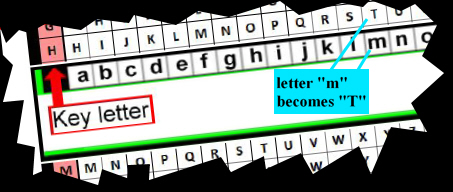
Codes: The Vigenere Grid
The Vigenere Grid is the same system as used by real spies to securely send and receive messages. We're going to see how you can send messages to your agent that are almost impossible to break, even by computers! If you're new to making and breaking codes, you might prefer to look at the easier Caesar Codes first. Getting ready...You and your agent both need to download and print out this sheet. Carefully cut out the cursor, so it's ready to use with the grid. You and your agent need to have agreed on a secret KEY. The KEY can be a sentence, a poem or even a chapter of a book. Anybody who doesn't know the key will not be able to crack your message! You'll need extra paper and pencils. How to write codeTo make things clear, your original uncoded message is called plaintext. Your plaintext should always be written out in lowercase letters. The coded message is called CODETEXT and is written in capitals. (This stops you getting confused later on.) Underneath each letter of your plaintext, write out the agreed key letter by letter. Just for fun, our key is going to be "Humpty Dumpty sat on a wall..."
Use the grid and cursor to change each letter of your plaintext into codetext as follows:.
For the first letter "m" we see the key is H. We slide the cursor up so the arrow points to H, then we can see the codetext letter above m is T. That's the first letter of the message! Keep going until you've coded your whole message. Note: when the key letter is "A" then the CODETEXT letter and the plaintext letter will be the same. If you look at our message above, where the key letter is "A" then i becomes I. How to decode a messageWrite out the CODETEXT message, then write the key above it. Starting with the first letter, move the cursor to the correct key letter. Look along the codetext letters on the grid to see which plaintext letter on the cursor you get. Here, "T" becomes "m". Keep going... If you'd like to see some other types of code look at our CODES Home Page. | ||
|
|



 Slide the cursor up the grid so that the arrow points to the correct key letter. Look along the cursor and see what CODETEXT letter on the grid sits above the plaintext letter on the cursor.
Slide the cursor up the grid so that the arrow points to the correct key letter. Look along the cursor and see what CODETEXT letter on the grid sits above the plaintext letter on the cursor.